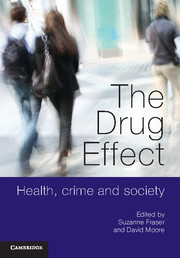Book contents
- Frontmatter
- Contents
- List of contributors
- Acknowledgements
- Introduction
- Part 1 Drug use as social and cultural practice
- Part 2 Drugs, health and the medicalisation of addiction
- Part 3 Drugs, crime and the law
- 9 Court-ordered treatment, neoliberalism and Homo economicus
- 10 Cannabis in cultural and legal limbo
- 11 Drugs, crime and the law in Australia
- 12 Reconceptualising harm reduction in prisons
- 13 Possessed
- Index
- References
11 - Drugs, crime and the law in Australia
from Part 3 - Drugs, crime and the law
- Frontmatter
- Contents
- List of contributors
- Acknowledgements
- Introduction
- Part 1 Drug use as social and cultural practice
- Part 2 Drugs, health and the medicalisation of addiction
- Part 3 Drugs, crime and the law
- 9 Court-ordered treatment, neoliberalism and Homo economicus
- 10 Cannabis in cultural and legal limbo
- 11 Drugs, crime and the law in Australia
- 12 Reconceptualising harm reduction in prisons
- 13 Possessed
- Index
- References
Summary
Although prohibition is the dominant approach to regulating illicit drugs throughout much of the Western world, the criminal justice system is limited in minimising illegal drug supply and use. After outlining current Australian law enforcement statistics on illicit drug seizures, this chapter reviews a sample of cases decided between January and June 2010 to illustrate how criminal courts determine legal responsibility and sentences for drug trafficking and related activities. The case analysis highlights how a dominant focus on retribution and deterrence overrides the effects of various individual factors that contribute to many low-level trafficking offences. Although this emphasis might justify a criminal conviction and punishment, an alternative evidence-based strategy that aims to reduce drug-related harm appears to be more appropriate, particularly for low-level suppliers who also use illegal drugs. The supervised provision of cannabis or heroin to registered users will not necessarily eliminate all problems associated with illicit drug supply. However, these harm reduction methods can help contain the effects of questionable legal principles, harsh sentencing and law enforcement corruption under the criminal law and prohibitionist philosophy.
Trends in contemporary drug law enforcement
Since the late 1990s Australia's ‘zero tolerance’ policies have usually been examined in relation to the use of illicit drugs rather than the more complex issues associated with their supply. The evils of drug trafficking appear beyond question, and calls for more intensive law enforcement activity and harsher criminal punishments aimed at those who ‘prey on our children’ or ‘peddle death’ frequently appear in the Australian media. However, several intricate problems emerge when assessing whether current law enforcement strategies, court processes and criminal punishments genuinely reduce drug-related harm or the scale of the illegal drug trade.
- Type
- Chapter
- Information
- The Drug EffectHealth, Crime and Society, pp. 189 - 208Publisher: Cambridge University PressPrint publication year: 2011



